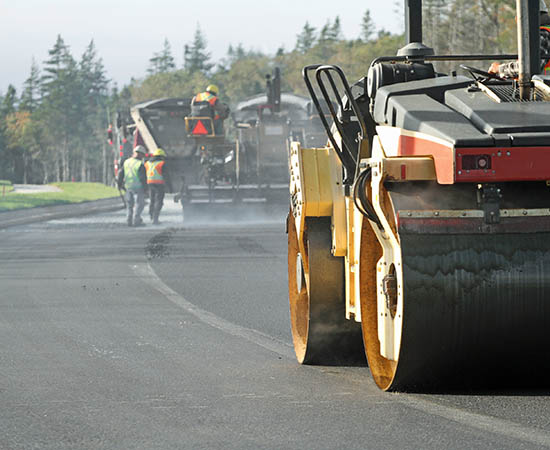Materials in Road Building are the lifelines of modern civilization, connecting people, places, and goods. They play a pivotal role in economic growth, transportation efficiency, and overall development. To ensure safe and durable road infrastructure, it is essential to employ the proper techniques and materials in road construction. In this blog, we will explore the latest advancements in road building, focusing on innovative techniques, sustainable materials, and asphalt maintenance services that are shaping the future of transportation.
Modern Road Construction Techniques
Asphalt Recycling
Traditional road construction often involves removing and disposing of old asphalt layers. However, the technique of asphalt recycling has gained popularity. It involves milling and reusing the existing asphalt to create a new road surface.
Cold In-Place Recycling (CIR)
CIR is an eco-friendly method that rejuvenates the existing pavement by milling and mixing it with a bituminous emulsion. The resulting material is laid back onto the road, reducing the need for new materials and minimizing construction time
Warm Mix Asphalt (WMA)
WMA is a replacement for standard hot mix asphalt. It allows asphalt to be produced and laid at lower temperatures, decreasing energy consumption and greenhouse gas emissions. This technique also improves the workability of asphalt, enhancing the overall quality of the road.
Geosynthetics
More and more construction companies are realizing the advantages of integrating geosynthetic materials into their different road construction types projects. Among them, geotextiles and geogrids stand out for their capacity to provide stability, reinforcement, and drainage. This not only minimizes maintenance requirements but also increases the longevity of the roads, making them a more affordable alternative in the long term. Incorporating these groundbreaking materials guarantees that road builders complete their projects to the most rigorous standards, offering dependable and secure transportation infrastructure for many years.
Intelligent Compaction
Modern road construction machinery is outfitted with cutting-edge intelligent compaction technology, which employs advanced sensors to closely monitor the density of the soil or asphalt being laid in real time. This cutting-edge technology guarantees uniform compaction and optimal road quality, leading to smoother and tougher roads that can endure heavy traffic and unfavorable weather conditions.
Sustainable Road Building Materials
Recycled Asphalt Pavement (RAP): RAP is a sustainable material created by milling and reusing old asphalt. It reduces the demand for new asphalt and conserves natural resources. RAP can be used in various layers of the road, contributing to sustainability goals.
Recycled Concrete Aggregate (RCA): Crushing and reusing concrete from demolished structures produces RCA. It is a cost-effective alternative to traditional aggregates and reduces the environmental impact associated with mining natural aggregates.
Bio-based Binders: Researchers are exploring bio-based binders made from renewable resources like plant oils. These binders have the potential to replace petroleum-based binders in asphalt production, reducing the carbon footprint of road construction.
Rubberized Asphalt: Incorporating recycled rubber from old tires into asphalt mixtures improves road performance and diverts waste from landfills. Rubberized asphalt provides better resistance to cracking and reduces road noise.
Permeable Pavements: Permeable pavements allow water to pass through them, reducing runoff and alleviating flooding issues. Porous materials like pervious concrete or permeable pavers often make these pavements.
Challenges and Considerations
While these innovative techniques and materials offer significant benefits, there are also challenges to consider:
Cost
Investing upfront in sustainable materials may seem like a daunting task. By selecting durable and eco-friendly materials, you can significantly reduce your carbon footprint and save money on future maintenance and replacements. Moreover, sustainable materials often have eye-catching designs that can add a touch of elegance to your home or office. Thus, it is worth exploring your options and making the switch to sustainable materials.
Regulations
Before starting any construction or renovation project, it is essential to conduct comprehensive research on the local regulations and standards. Some materials or methods may not receive permission or may demand specific licenses or certifications. This can significantly affect the viability, expenses, and timeline of the project. It is advisable to seek advice from experts or professionals in this sector to ensure conformity with all essential regulations. By taking these measures, one can avoid expensive delays and guarantee the safety and excellence of the project.
Education and Training
Proper training ensures construction crews can effectively implement new techniques and work with innovative materials. In a rapidly evolving construction landscape, ongoing education and training programs are critical for equipping workers with the necessary skills to operate cutting-edge equipment, understand the intricacies of sustainable materials, and stay updated on safety protocols, ensuring the longevity and success of road-building projects.
Final Words
The road construction industry is transforming by adopting innovative techniques and sustainable materials. These advancements not only reduce the environmental impact of road building but also improve road quality, durability, and safety. As we move toward a more sustainable future, the choices made in road construction today will have a lasting impact on the world of tomorrow. By embracing these new approaches, we can pave the way to a brighter, more sustainable future for our infrastructure and the planet.











